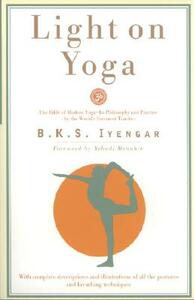You need to sign in or sign up before continuing.
Take a photo of a barcode or cover
I always feel at ease with yogic books. B.K.S. Iyengar certainly simplifies living the yogi way. It was easy to trust these words knowing his past which lead him into this life long inward journey.
Soothing and enjoyable.
A contemplative, reflective piece of work.
Soothing and enjoyable.
A contemplative, reflective piece of work.
This is just a book that gives in depth explanations of each pose, very helpful for reference.
Another must have yoga book! Starting with an introduction to the history and philosophy of yoga, this book is full of detailed descriptions and instructions of every single yoga pose. Photos of each pose and their physical and mental benefits are also included. The book ends with a series of yoga sequences that you can follow at home. I refer to this book regularly and am always finding new tips and info to help my practice develop.
Really the compendium of asanas for me. There are others out there, but I love this one.
This book can be a bit technical but definitely a must-have. I really enjoy the Introduction. I got just as much out of that as I did the rest of it.
A bit dry being more of a manual type of book but has every detail of poses and modifications. A definite read as you learn more about yoga, especially as an instructor. I keep it on hand.
Used this book to study for a yoga certification exam. It is a great overview of the main principals, but I found I had to supplement with the internet. Back in the days before internet, I can see how this book would have been (and still is) a sort of yoga bible. I will be using it for years to come. The only thing I don't like about this book is the photos of his poses. I believe it leads one to believe what so many believe about yoga, that you must be able to bend like a pretzel to do yoga, when in fact, this is not the case at all. A great resource, but don't be intimidated if you are a beginner.
I'm in love with this book. It is a great life Bible, and it helps solidify the emotional and subconscious effects yoga has on me. For anyone who's thought about practicing yoga, you will be more than inspired if you read the 50 page introduction to this book. There is also a huge section of this book dedicated to the poses and the effects of the poses, and the final section of the book is about breathing. Yoga is definitely more than flexibility and if anything, being tight and gaining flexibility gives even more evidence of the benefits of yoga.
Quote: "It is said: 'Work alone is your privilege, never the fruits thereof. never let the fruits of action be your motive; and never cease to work. Work in the name of the Lord abandoning selfish desires. Be not affected by success or failure. This equipoise is called Yoga.'" -B.K.S Iyengar p 26
"When the senses are stilled when the mind is at rest, when the intellect wavers not--then, say the wise, is reached the highest stage. This steady control of the senses and mind has been defined as Yoga. He who attains it is free from delusion." -B.K.S Iyengar p 26
Quote: "It is said: 'Work alone is your privilege, never the fruits thereof. never let the fruits of action be your motive; and never cease to work. Work in the name of the Lord abandoning selfish desires. Be not affected by success or failure. This equipoise is called Yoga.'" -B.K.S Iyengar p 26
"When the senses are stilled when the mind is at rest, when the intellect wavers not--then, say the wise, is reached the highest stage. This steady control of the senses and mind has been defined as Yoga. He who attains it is free from delusion." -B.K.S Iyengar p 26
Since I got back into the habit of a daily yoga practice, I started digging up books on the topic – because that’s what I do. My dad enthusiastically recommended this one as an absolute classic that anyone with a serious interest in yoga should have on their shelf. While I usually take his book recommendations with several grains of salt, he is definitely a subject matter expert here, so I fully trusted his opinion on “Light On Yoga”.
The first 30 or so pages are especially crucial: it’s where Iyengar discusses the many branches of yogic philosophy, how it applies to living, practicing and studying. The practice of asanas is only one branch of the philosophy and spiritual practice of yoga, and Iyengar obviously considers that a yogi who practices asanas but neglects the other aspects only has a fragmentary understanding of yoga. This text is fascinating, but also generously peppered with Sanskrit terms, and to be honest, that makes it occasionally confusing. I get why the section was not edited to be too simplified, but I can also see how that would make it a bit intimidating for newbies.
The bulk of the book is an extremely detailed section on asanas, with many photos of Iyengar himself demonstrating the poses and their different stages. He goes through step-by-step instructions on how to get into the pose, explains the Sanskrit name for it and describes the effect the pose will have on the body. Most modern illustrated yoga guides tend to classify the asanas by type (standing, sitting, back bends, inversions, etc.), but here, they are more or less organised by levels of difficulty, getting progressively more advanced and demanding as so go through the book. That being said, the asanas are also not displayed in a learning sequence – those are further along in the book, in the appendix. The section following the asanas is a list of breathing guidelines and techniques, and a discussion on chakras.
While I can absolutely see how great this book is as a reference, I must say that I found it rather impractical. For example, the appendix containing Iyengar’s asana practice plans is essentially a list of asanas (either grouped by weeks of practice or by an affliction the practitioner would like to address), referred to by their Sanskrit names and with the photo number next to it. There isn’t even the page number at which you can find the poses in there! This is a rather frustrating layout. Maybe I’ve been spoiled by other books, which have more visual layouts, but I’m afraid I found this one rather hard to work with.
As a foundational text of the modern practice of yoga, anyone with a serious interest should definitely have this on their shelf. It is not always breezy, nor is it really the right practical book with which to learn yoga, but it is incredibly informative.
The first 30 or so pages are especially crucial: it’s where Iyengar discusses the many branches of yogic philosophy, how it applies to living, practicing and studying. The practice of asanas is only one branch of the philosophy and spiritual practice of yoga, and Iyengar obviously considers that a yogi who practices asanas but neglects the other aspects only has a fragmentary understanding of yoga. This text is fascinating, but also generously peppered with Sanskrit terms, and to be honest, that makes it occasionally confusing. I get why the section was not edited to be too simplified, but I can also see how that would make it a bit intimidating for newbies.
The bulk of the book is an extremely detailed section on asanas, with many photos of Iyengar himself demonstrating the poses and their different stages. He goes through step-by-step instructions on how to get into the pose, explains the Sanskrit name for it and describes the effect the pose will have on the body. Most modern illustrated yoga guides tend to classify the asanas by type (standing, sitting, back bends, inversions, etc.), but here, they are more or less organised by levels of difficulty, getting progressively more advanced and demanding as so go through the book. That being said, the asanas are also not displayed in a learning sequence – those are further along in the book, in the appendix. The section following the asanas is a list of breathing guidelines and techniques, and a discussion on chakras.
While I can absolutely see how great this book is as a reference, I must say that I found it rather impractical. For example, the appendix containing Iyengar’s asana practice plans is essentially a list of asanas (either grouped by weeks of practice or by an affliction the practitioner would like to address), referred to by their Sanskrit names and with the photo number next to it. There isn’t even the page number at which you can find the poses in there! This is a rather frustrating layout. Maybe I’ve been spoiled by other books, which have more visual layouts, but I’m afraid I found this one rather hard to work with.
As a foundational text of the modern practice of yoga, anyone with a serious interest should definitely have this on their shelf. It is not always breezy, nor is it really the right practical book with which to learn yoga, but it is incredibly informative.
Essential reference for every yoga teacher and any serious yoga practitioner.


